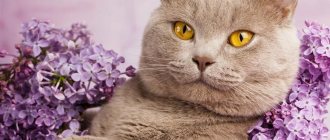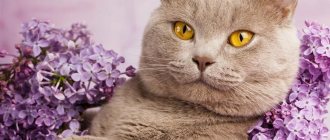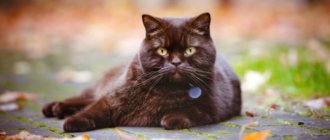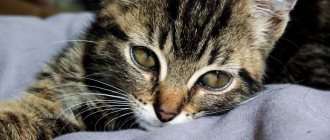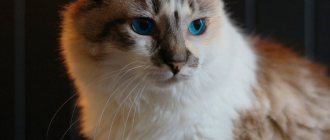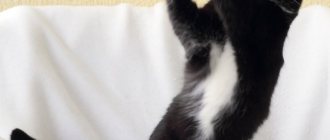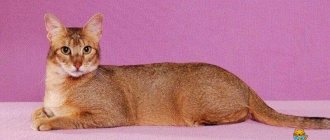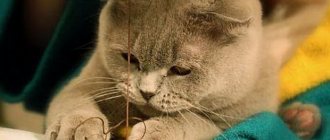The British Shorthair is one of the most popular cat breeds today. It occupies a leading place in popularity in its native country, and in Russia there is a representative of this genus in every second family.
In fact, this is a very old species of cat, the ancestors of the British appeared back in the 1st century AD. Let's take a closer look at this beautiful and ancient breed.
Here is a photo of a classic British Shorthair cat with blue color and bright orange eyes.
Description
Despite constant crossings with other breeds, the British cat has retained its main features and, according to the description, is practically no different from representatives of its breed of the last century.
The small size is more than compensated by the power and massiveness of this animal; females weigh on average 5 kg, and males 7 kg.
On the large and round head there are widely spaced round eyes, which, together with the small nose and ears, gives the British a serious appearance.
Note!
Snowshu: description and characteristics of the cat, care and maintenance- Munchkin: description and characteristics, care and maintenance of a short-legged cat
Thai cat: description and characteristics, care and maintenance, choosing a kitten
In general, they have a wide chest and good muscles. This entire stocky body is supported by short but strong legs. The tail is thick and short.
The fur of these cats is short, but very dense and fluffy, which makes them look like plush toys. There are more than 60 colors of the British Shorthair cat, but monotonous blue and lilac are considered classic.
Nurseries
"PLUSH GOLDEN KITTY" is a small home-type nursery. “British” breeds are even bred here in the rare golden color.
Moscow nursery BRIstyle. Pedigree breeding of the "British".
VIJUHA.com cattery is a large and friendly family of “British”.
In the ABSOLU nursery, in addition to the “British” ones, they also breed Scottish Folds. Specializes in incredibly beautiful colors.
Miracle Cats Cattery - here they breed “British” cats with patterned colors, without losing the characteristics of the breed.
Tinessa – breeding of “British” rare and classic colors in Yekaterinburg.
Cattery "RuStyle". In addition to the British, the Selkirk Rex breed is bred.
Scottish cattery "Camelia Cats" (Kamensk-Uralsky). This is the “home” of the Scottish Fold and Straight, as well as the Highland Fold and Highland Straight.
Character
Generally the British are very friendly. It is impossible to force a cat of this breed to let out its claws, and if he doesn’t like something, he simply leaves, showing his disdain for the offender. It also reminds us of another striking feature - restraint.
Willfulness often manifests itself in his character. If you want to waste time, then try to force the cat to do something he doesn't want. But at the same time, the British are smart and are able to learn even the most complex commands.
Despite all the apparent indifference, these cats love their owners, and often meet them from work and lie next to them during rest. Another thing is that because of their waywardness they do not show their love so vigorously.
Note!
- Bengal cat: description, characteristics and maintenance of an exotic breed
- Norwegian Forest Cat - description of the breed, character, habits and maintenance of the Norwegian (110 photos and videos)
- Cat litter - detailed review, prices, how to choose, where to buy
All these features make Britons ideal pets for a business person, especially since these cats are self-sufficient and can easily tolerate several days of loneliness, so you can calmly go about your business without worrying about the cat.
Features of feeding
Contrary to the persistent stereotype, food from the human table is contraindicated for cats. This breed is no exception.
Feeding a stray animal a bowl of soup is good, but giving cutlets or fried meat to a purebred cat is, by and large, criminal. There are 2 options for pet diet: dry or natural food. You need to decide on the type of feeding right away, because as an animal grows up, it is reluctant to change its eating habits.
The advantage of dry food is its balanced composition. The cat receives a full range of nutrients.
As for the formation of a diet taking into account the weight and age of the pet, all the information is available on the packaging. If you use “drying” for feeding, you need to make sure that the cat has access to water. The class of food for purebred pets is only “premium” or “super-premium”.
It is impossible to turn feed into a savings item. Otherwise, the results of this frugality will affect the condition of the pet’s coat, its activity and general well-being. If you don’t have money to buy expensive food, you will have to use natural food.
Kitty
Up to 6 months, the number of meals per day is at least 4 times, in small portions.
The baby's diet includes:
- Meat products . Chicken, lean beef. The meat can be used boiled or raw as minced meat. To avoid worms, meat should first be frozen or doused with boiling water. Chicken by-products are useful, but they can only be given to the kitten boiled.
- Boiled sea fish : devoid of bones and fat. Fish should be given once a week, not more often.
- Fermented milk products (milk should not be given!): kefir, cottage cheese, yogurt without additives.
- Boiled chopped vegetables (carrots, zucchini, cabbage). It is advisable to mix them with meat. In its pure form, it is unlikely that a cat will eat something like this.
- Boiled chicken egg yolk or raw quail egg – once a week.
- Porridge made from buckwheat, rice and oatmeal.
To ensure that your baby enjoys eating porridge, boiled cereal is mixed in a 1:2 ratio with minced meat and tiny meatballs are made. Some time before feeding, you should remove them from the freezer.
Adult cat
A grown or adult animal is fed less often than a kitten:
- 6-8 months – three times a day.
- From 8 months – 2 times a day.
The weight of 1 serving for an adult is from 150 to 300 g, depending on the weight of the pet. The basis of the diet is meat, fish is given 1-2 times a week. An addition to the diet is porridge. Cats especially love rice. Meat products include lean beef, chicken, rabbit, veal or turkey. Products made from sour milk are healthy, but not salty and low in fat.
Cats love greenery and sometimes devour houseplants with gusto. This cannot be allowed. Firstly, they are not planted for this purpose, and secondly, the pet can be poisoned. It is much wiser to pamper your pet with lettuce, parsley and dill. You can buy a special set of grass seeds and sow your cat’s own “lawn.” Cats also love oat sprouts.
Take care of your pets, and these animals with aristocratic manners will give you many joyful moments.
Nutrition
This is a sore subject for the British, as they are big food lovers. Therefore, you will have to closely monitor your pet’s portions. You have two feeding options:
- Dry food. In this case, it is better not to skimp and buy high-quality food for your pet, so you will save a lot of money on treatment. Be sure to make sure your cat drinks enough water, or you can simply soak the food.
- Natural food. Everything here is the same as for other cats, nothing special, the main thing is don’t give anything forbidden and everything will be fine. Do not forget to periodically give your pet a vitamin complex.
Necessary conditions of detention
Pets living within four walls require physical exercise to maintain good psychological and physical shape. The cat should be involved in various games and outdoor activities every day. The most common and primitive game is a string with a candy wrapper at the end. There are many varieties of it - a “fishing rod”, a wave with feathers, etc., just to awaken the hunter’s interest. To diversify your pet’s leisure time, you need to buy or make various equipment for training and warming up. These can be boards or branches that are strong enough and processed appropriately. Climbing on them not only gives the cat great pleasure, but also provides excellent exercise. By the way, sleeping on one of the top shelves is every cat’s dream. If you build vertical stands for climbing, they can also serve as excellent scratching posts.
Health
Since Britons are naturally bred, excellent health comes with them from birth. The only thing to be wary of are breed-specific diseases: heart disease, parasites, diarrhea, obesity, hair loss and nail fungus.
These troubles will bypass you if you monitor your pet’s health, take it for checkups and vaccinate it on time.
On average, the British live 10-15 years, some live up to 20, it all depends solely on the owners. A calm environment and a balanced diet will allow your pet to live a long and happy life.
Buying a kitten
Despite its popularity, this breed is expensive, the minimum price for a kitten is 7 thousand, but if you want a purebred pet with a pedigree and everything included, then you will have to find about 60 thousand rubles. Yes, this is a lot of money, but with such a pet the doors of any exhibitions will be open for you.
This breed of cat is not suitable for every person, because not everyone can get along with such a self-sufficient animal. But, if you still decide, then pay attention to the white British cat, she will amaze you with her beauty.
